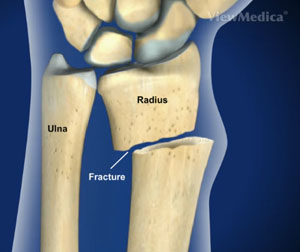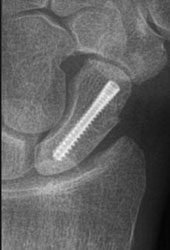Wrist Fractures
What is a Wrist Fracture?
Wrist fractures, more commonly referred to as broken wrists, are a very common occurrence. The wrist is a complex joint consisting of eight carpal bones and their numerous articulations, which provide a great deal of flexibility and motion. These eight bones, each with a unique block-like shape, are arranged in roughly two rows. The proximal row, closest to the forearm, is comprised of the scaphoid, lunate, triquetrum, and pisiform bones. The distal row, which articulates with the metacarpal bones of the hand, is comprised of the trapezium, trapezoid, capitate and hamate bones. Any of these bones can sustain a fracture, although some bones are more prone to fracture than others.

What are the different types of Wrist Fracture?
Distal Radius Fractures/Colles Fractures
Commonly, fractures of the distal radius of the forearm are called wrist fractures. Indeed, a full three quarters of fractures of the upper extremity involve a fracture of the distal radius. Distal Radius fractures can occur in many different ways and the most common types are Colles fractures, Smith fractures, Barton Fractures, and Chauffer’s fractures.

Scaphoid Fractures
When wrist fractures are limited to those which include only the carpal bones, the scaphoid is, by far, the most commonly fractured of the carpals. Its anatomic location and precarious blood supply lend unique considerations for diagnosis and treatment.

Carpal Bone Fractures
Carpal bone fractures involve the eight bones that form the wrist. Fractures of the lunate, triquetrum, pisiform, trapezium, trapezoid, capitate, and hamate bones are the focus of this article.
What causes a Wrist Fracture?
In general, fractures of the carpal bones are due to falls on an outstretched hand or a direct, traumatic blow.
Lunate fractures occur when the wrist is hyperextended in a fall or from hitting the heel of the hand on a hard surface. The lunate is also prone to dislocation when the scaphoid is fractured.
A triquetrum fracture commonly occurs during participation in contact sports. It occurs when the hand is bent backwards and forced toward the ulna, resulting in wrist hyperextension.
Capitate fractures occur with a fall onto an outstretched hand. In this case the wrist is flexed and the force occurs toward the radius.
The hamate is typically fractured in sports when a golf club or baseball bat is swung and hits a stationary object.
Fractures of the trapezium and trapezoid are rare as they require a combination of odd body position and trauma. A trapezium fracture requires a direct blow to the wrist when the thumb is adducted. Trapezoid fractures occur when the second metacarpal butts up against it.
The pisiform, a sesamoid bone nestled in the flexor carpi ulnaris tendon, rarely fractures. When it does it is the result of a fall on an outstretched, dorsiflexed hand.


What are the symptoms of a Wrist Fracture?
A fracture of the carpal bones of the wrist may present with swelling and bruising. There will usually be tenderness to palpation over the affected bone. Range of motion may be decreased. Lunate fractures will present with weakness in the wrist and pain reproduced by palpating the third metacarpal bone. Hammate fractures will present with immediate pain over the area of the thumb at the moment of injury. The pain worsens with any type of gripping activity.
How is a Wrist Fracture diagnosed?
Plain film X rays are needed for proper evaluation of a suspected carpal bone fracture. AP, lateral, and oblique X rays along with a carpal tunnel view are essential. If a fracture of the lunate or capitate is suspected, CT will be needed as these bones are not well visualized on X ray.
How is a Wrist Fracture treated?
Non Surgical
Immobilization is the standard of care for carpal bone fractures without displacement.
A non-displaced, non-dislocated lunate fracture can be immobilizated.
Fractures of the triquetrum are classified as either chip fractures or body fractures. A chip fracture requires splinting for 3 weeks. A non-displaced body fracture requires casting for 6 weeks.
A non-displaced capitate fracture can be immobilized after successful closed reduction.
A non-displaced hamate fracture requires 6 weeks of immobilization in a cast.
Fractures of the trapezium are classified by their presence in the trapezial body or ridge. Non-displaced trapezial body fractures require a thumb spica cast for 6 weeks. If the fracture is present on the ridge, closed reduction is followed by immobilization in a thumb spica cast for 6 weeks.
Pisiform fractures are placed in a cast for 6 weeks and rarely require surgical intervention.
Surgical
In a fracture involving the lunate there are several indications for surgery. If imaging studies show evidence of bone fragmentation, instability, or arthritis, various surgical techniques may be necessary. These goals of these procedures are to reduce stress and restore blood supply to the bone for proper healing. In some cases the lunate may need to be removed.
Displaced fractures of the body of the triquetrum can be pinned percutaneously or opened, reduced, and fixed internally.
Displaced capitate fractures require open reduction and internal fixation.
Likewise a displaced hamate fracture will require surgical reduction and fixation followed by 6-8 weeks of immobilization. Hamate fractures involving the hook may not heal in which case the hook is usually removed to prevent the adjacent tendons from rupturing and to relieve the pain.
Fractures involving the body of the trapezium with evidence of displacement will require open reduction and internal fixation, usually with K wires or screws.




How can Dr. Knight help you with wrist fractures?
Over his years in practice, Dr. Knight has gained much experience treating traumatic wrist injuries, and has returned some of the most horrific wrist injuries to functional, pain-free use.
Distal Radius Fracture Testimonial
“Dr. Knight is truly the best. He was clear, concise, patient with my questions, and available when I had a concern. His staff was excellent and helpful at every turn. Having never broken anything before I was nervous and unsure as to what “recovery” really meant. Dr. Knight performed an excellent job (my scar may even fade with time) and I could not be happier with the experience.” – Lindsey
Dr. Knight is excited to be serving residents throughout the Dallas area. He’s one of the best hand doctors in Dallas and if anyone can help, he can. Come to our Dallas office or Southlake hand and wrist center at your convenience.
Videos
Animated Videos
Surgical Videos
Note: The following videos contain graphic images.
(817) 382-6789
Disclaimer
HandAndWristInstitute.com does not offer medical advice. The information presented here is offered for informational purposes only. Read Disclaimer

























